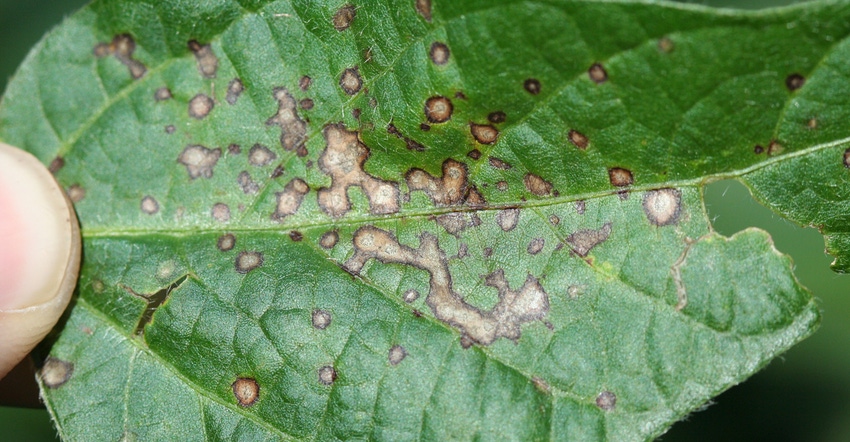
In 2019, wet conditions in Iowa and other Midwestern states were conducive for soybean diseases like white mold. Last year was dry for much of the state, but Daren Mueller, Iowa State University Extension plant pathologist, notes many fields that experienced white mold two years ago will be planted to soybeans this year — and white mold will be one disease to keep an eye out for in 2021.
“Up until 2020, northwest Iowa had a string of three years with elevated levels of white mold. 2020 gave them a little reprieve, but they’re going to be rotating soybeans back into those fields, and the inoculum level could be up a little bit,” Mueller says.
White mold favors humid conditions and thick canopies can create a suitable microclimate.
“The disease is driven by sclerotia, which germinate and create apothecia, which create spores that cause the disease,” he says. “Growers need to determine whether conditions are right for sclerotia to survive in moisture and produce apothecia, which need a canopy to create spores. If you have good soil moisture, a thick canopy and a history of white mold, that field’s at a higher risk.”
With fungicide applications, timing can make all the difference. That’s why Mueller recommends watching for the right conditions. If conditions are dry, it may be best to wait until R3.
“If you can push the application closer to R3, that gives a couple weeks to know whether white mold is going to develop and know the fungicide has a good chance of controlling it,” he says.
Charcoal rot challenges
If the season turns out dry, however, there will be higher risk of other diseases. One of the diseases favored by dry conditions is charcoal rot.
“I saw a little bit of charcoal rot showing up on the field edges last year. If we continue to have drier conditions for a second year in a row, that could be more of a problem,” Mueller says.
Plants infected with charcoal rot typically produce slightly smaller leaflets, which eventually yellow, then wilt and turn brown. These symptoms usually show up during the reproductive stages.
“It’s a hard disease to identify. If you have patches that don’t look as healthy as they should, you can split those stems and look for signs of the fungus on the lower stem,” Mueller says. “The problem is it’s a fungal disease, but it’s all in the roots and lower stems. So it’s one of those diseases that by the time you can see it, you have to grin and bear it. But it’s important to remember you don’t want to be applying fungicides on it and losing money, because it doesn’t work.”
Resistant frogeye spreading
What will likely be a bigger threat going into 2021, however, is frogeye leaf spot – specifically frogeye leaf spot resistant to QoI, or strobilurin.
“I have not found a sensitive isolate of frogeye leaf spot in the last three years. When I talk to farmers I say, ‘If you have frogeye, assume it’s resistant to QoI fungicides,’“ Mueller says. “In 2020, 100% of the isolates we tested were resistant.”
Mueller adds that many fungicide premixes rely on strobilurin, or QoI, chemistries. So, for example, if using Priaxor on frogeye that’s resistant to pyraclostrobin — a strobilurin and one of the two active ingredients in Priaxor — the grower is relying on just the other active ingredient, Xemium.
“When you have resistance develop with premixes, suddenly half or part of that premix is not effective. We have to look at what’s left,” he says.
That’s why it’s important for growers to do their homework when evaluating their fungicide options.
“The best strategy is to start with a resistant variety – there are plenty of resistant varieties that are effective, and there are still quite a few fungicides that work,” Mueller says. “If you’re worried about frogeye, keep watching reports. If it’s dry, you shouldn’t have to use a foliar fungicide. But if we have humid wet weather, you may want to consider it.”
A year of SDS?
After two years with low incidence of sudden death syndrome, Mueller says in 2021, growers may be facing a higher risk of the disease.
“We typically don’t go three years in a row without SDS. It also means we have two years where people aren’t really getting good data from variety trials,” he says. “If it’s a dry year, if charcoal rot ends up being a problem, we’re not going to be as worried about SDS. If we do have moisture, it could be another year of SDS problems.”
And it’s been difficult to show how different practices affect inoculum levels. Although earlier studies showed downed corn kernels can increase inoculum levels, subsequent studies have not shown that to be the case. However, there are small steps that can be taken — such as adjusting planting date, but only when it makes logistical sense and won’t affect yield.
“Don’t delay planting to prevent SDS, because you’re reducing yield potential,” Mueller says. “If you have a field with SDS history, try to plant it last, and plant those with less risk first.”
About the Author(s)
You May Also Like






